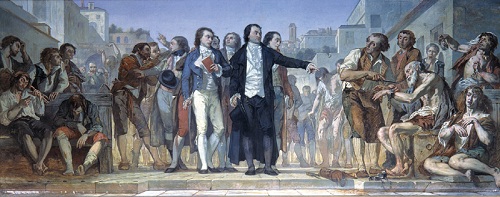
Image Credit: Archives of General Pyschiatry
When historians seek gathering metaphors to describe the French Revolution--with its violent upheavals, experiments in re-arranging calendar time, and, of course, the demands for liberty and equality that underwrote these events--they rarely describe the atmosphere or environment of the period as particularly stable or "sane." And yet the work of Philippe Pinel--a progressive French physician who helped lay the groundwork for a major shift in mental health treatment--has been nonetheless remembered as a figurative crystallization of the Revolution's lofty, humanist goals--goals which in turn influenced the trajectory of ninenteenth century psychiatry. Today, I seek to briefly explore how 19th century visual re-enactments of Pinel's participation in a highly mythicized (and mostly apocryphyl) event--a ritualized "unchaining" of the captive patients-- were used to remind French citizens of the virtues of republican government during times of national upheaval.
Recent comments
2 years 29 weeks ago
2 years 44 weeks ago
2 years 44 weeks ago
2 years 50 weeks ago
3 years 4 weeks ago
3 years 4 weeks ago
3 years 4 weeks ago
3 years 6 weeks ago
3 years 6 weeks ago
3 years 6 weeks ago